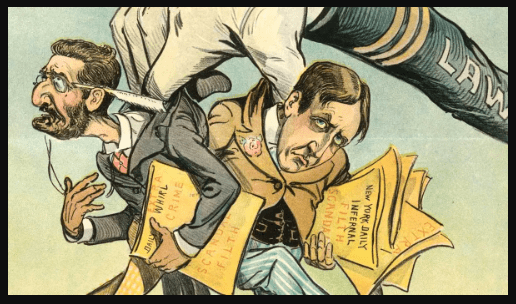
Powered by Froala Editor
Freedom of press main cause of yellow Journalism
Powered by Froala Editor
What is yellow journalism, and how did this term come about?
Yellow journalism is a type of journalism that presents little or no legitimate, well-researched news and instead uses eye-catching headlines, exaggerated stories, and misleading information to increase newspaper sales and readership. The term "yellow journalism" originated in the late 19th century, referring to the use of yellow ink in a comic strip published by Joseph Pulitzer, a leading practitioner of the style.
Yellow journalism itself is not illegal, as it is protected by freedom of the press in many countries. However, the use of false information and libelous content in journalism is illegal and can result in legal action. While yellow journalism may not be illegal, it is often criticized for its lack of journalistic integrity and its potential to mislead and manipulate the public.
Does yellow journalism provide an important function for society?
I believe Yellow Journalism is corrupt. The writing is very biased, which steers the story away from the facts. It traps readers into believing something that is severely blown out of proportion. Readers get hyped up from the exaggerated writing...over nothing!! Yellow journalist are not writing to inform the public; they are writing to win a popularity contest.
Why is yellow journalism called yellow?
The term likely derives from a comic strip character known as the Yellow Kid, a boy usually dressed in a yellow nightshirt. The character was created by Richard F. Outcault and first became popular in the New York World, a highly sensational newspaper. Outcault was hired by a competitor, the New York Journal American, and both papers published versions of the character drawn by different artists.
These papers became known as “the yellow kid papers” and the sensational, often wildly inaccurate reporting became known as “yellow kid journalism” and later just “yellow journalism.”
The word “yellow” also has a slang meaning of “cowardly” in American English, something that I suspect contributed to the lasting use of the term “yellow journalism” long after the comic strip character faded into obscurity.
What should be done to put a full stop on the yellow journalism?
Putting a full stop on yellow journalism involves a combination of individual and collective efforts. As an individual, you can practice critical thinking and media literacy by verifying information from multiple reliable sources before believing or sharing it. Supporting ethical journalism by subscribing to reputable news outlets and reporting misleading or false information can also make a difference. On a larger scale, promoting media literacy education in schools, advocating for transparent and accountable media practices, and holding media organizations accountable for ethical standards can help combat yellow journalism. It's an ongoing process that requires vigilance and participation from both individuals and society as a whole.
Yellow journalism is a controversial style of journalism. Some people argue that it is unethical and that it undermines the credibility of the news media. Others argue that yellow journalism is simply a reflection of the public's appetite for sensationalized news.
Whether or not you agree with yellow journalism, it is a style of journalism that has had a lasting impact on the news media. It is important to be aware of the characteristics of yellow journalism so that you can make informed decisions about the news you consume.
More Aspects:
The relationship between freedom of the press and yellow journalism is complex and multifaceted. While freedom of the press is a fundamental right and a cornerstone of democracy, it can also be misused to spread misinformation and sensationalism. Yellow journalism, a type of journalism characterized by its use of exaggerated headlines, fabricated stories, and sensationalized reporting, emerged in the late 19th century, coinciding with the expansion of freedom of the press in the United States. Several factors contributed to the rise of yellow journalism, including: The expansion of literacy and readership: As more people gained access to newspapers, publishers sought to attract and retain readers by using more captivating and attention-grabbing methods. The rise of mass production and distribution: The development of new printing technologies and transportation systems enabled newspapers to reach a wider audience, increasing competition for readership. The pursuit of profits: Newspapers became businesses driven by advertising revenue, putting pressure on publishers to increase circulation and generate interest in their publications. In this competitive environment, some publishers adopted yellow journalism tactics to boost their sales. They employed sensational headlines, exaggerated stories, and fabricated accounts to capture the public's attention and sell more newspapers. This approach proved effective in attracting readers, particularly those interested in crime, scandal, and adventure. However, yellow journalism came at a cost. It undermined the credibility of the press, eroded public trust in journalism, and contributed to the spread of misinformation. The exaggerated and often fabricated stories presented in yellow journalism publications blurred the lines between fact and fiction, making it difficult for readers to distinguish between reliable and unreliable sources of information. The rise of yellow journalism highlighted the need for ethical standards and responsible journalism practices. As a result, professional organizations and codes of ethics were developed to guide journalists and promote ethical reporting. These efforts aimed to restore the credibility of the press and uphold the principles of responsible journalism. While freedom of the press remains essential for a healthy democracy, it must be exercised with responsibility and ethical considerations. Journalists must strive to provide accurate and truthful information, avoiding sensationalism and fabrications that undermine the public's trust in the media. The balance between freedom of the press and responsible journalism is crucial for maintaining a well-informed and engaged citizenry.
Powered by Froala Editor